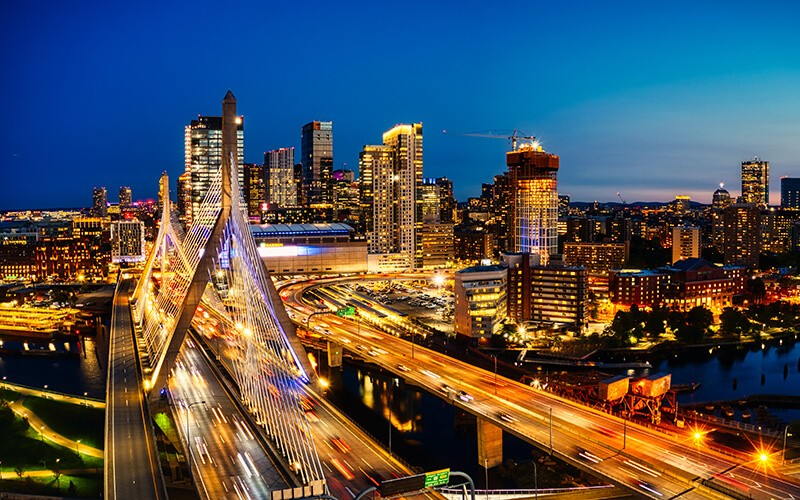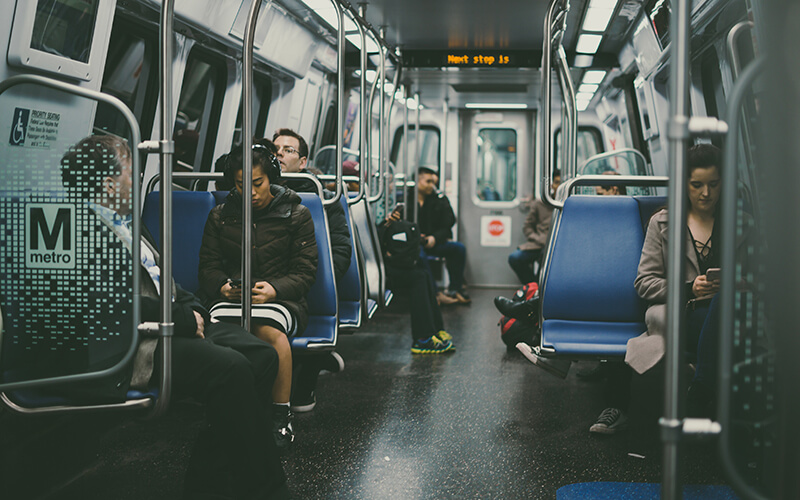
Washington, D.C., traffic at rush hour. Your commute affects air pollution and climate change more than you probably know.
If there’s one thing that almost everyone can agree on, it’s that sitting in rush hour traffic is not fun. Yet, three-quarters of Americans drive themselves to and from work, according to the U.S. Census Bureau.
Beyond being a daily headache, commuting actually has a major impact on the Earth’s atmosphere and environment. Every time you drive a gasoline-powered car, several chemicals are released into the air from the combustion of the fuel, including pollutants like nitrogen oxides (NOxgases), particulate matter (PM), and volatile organic compounds (VOCs)—as well as greenhouse gases like carbon dioxide (CO2) and methane.
These pollutants can lead to serious problems: worsening air pollution and the greenhouse effect, which contributes to climate change.
Air Pollution and Photochemical Smog
In addition to their toxicity that can cause cardiovascular and respiratory issues, NOxgases and VOCs react with sunlight to produce ozone. While ozone in the upper levels of the atmosphere protects life on Earth from the sun’s harmful ultraviolet rays, ground-level ozone—also known as smog—can cause respiratory issues in humans and damage plants. “We often say ‘good up high, bad nearby,’” said Georgia Murray, AMC’s staff scientist.
Although these ozone-causing pollutants do come in part from industrial sources, the U.S. Environmental Protection Agency (EPA) reports that more than 55 percent of all NOxgas emissions originate in the transportation sector, compared to less than 10 percent of overall emissions of VOCs and PM that come from transportation. That’s why cities with congested roadways often suffer from smog and poor air quality.
The Clean Air Act of 1970 gave the Environmental Protection Agency authority to regulate emissions of these pollutants. while the agency’s oversight has resulted in cleaner air across the country, ground-level ozone remains a problem in many places.
“Even though we’ve seen real significant progress in cleaning up the source emissions, if you have a lot more cars on the road, you still have a lot more of that pollution there to create ozone,” Murray says.

Driving personal vehicles is one of the leading contributors to air pollution and greenhouse gas emissions.
The Greenhouse Effect and Climate Change
Driving personal cars is also one of the leading contributors to the increase of greenhouse gases in the atmosphere. Nationally, the transportation sector contributes 28 percent of all greenhouse gas emissions—the most of any sector—and personal vehicles make up more than half of those emissions. In the Northeast, transportation emissions of greenhouse gases are even higher, making up more than 40 percent of total emissions.
These gases contribute to what is known as the greenhouse effect. Heat from the sun is reflected back from the Earth’s surface into the atmosphere. Naturally occurring and human-created gases such as CO2, methane, and water vapor at the top of the atmosphere then trap in this heat. The more of these gases, the more heat is trapped, which leads to climate change.
Unlike NOxgases and other air pollutants that mainly have regional impacts—for example, a major highway’s impacts on a neighborhood it passes through—the concern with CO2and other greenhouse gases is also about total emissions worldwide. “It’s not like we’re worried about the CO2that’s emitted in the Midwest and its impact on New Hampshire,” Murray says. “What we’re worried about is the CO2emitted around the globe and its local impact.”
The EPA regulates greenhouse gas emissions from automobiles and power plants, but the Trump administration weakened many previously established rules. But Murray and other experts are hopeful that legal challenges and a new administration will reinstate these stricter policies on emissions.

Many states have implemented emissions goals that would strengthen local public transportation options, like buses and subways.
Considering your Commute
Aside from federal regulation, many states are setting their own emissions goals. On the East Coast, Massachusetts, Rhode Island, Connecticut, and Washington, D.C. recently signed a regional pact—the Transportation and Climate Initiative Program (TCI-P)—which will require fuel companies to purchase allowances that would be used to invest in lower-emission alternatives. Other New England and Mid-Atlantic states are also engaged in the program and have indicated that they want to be involved as the initiative moves forward.
“[The TCI-P] would allow states to invest money into the economy in a way that can reduce emissions even more,” says Murray, who submitted comments on the plan on behalf of AMC.
The alternatives that the TCI-P, as well as other strategic plans on local and regional levels, would invest in focus on creating better infrastructure for walking and biking, public transit, and electric vehicles. These commuting options are not equally accessible in all places, but the goal is to make them easier and available in more communities.
The best commute for the environment may be no commute at all. The COVID-19 pandemic has forced many employers to adapt to telecommuting. Many pollutants decreased significantly in the early weeks of state stay-at-home orders, with most Americans working from home. They shot back up toward pre-pandemic levels, however, as businesses and offices reopened later in the year.
Telecommuting may become more common after the pandemic ends and some employers consider the environmental, economic, and public health benefits of having employees continue to work remotely. But this solution is only a piece of the puzzle, Murray explained.
“Working from home is a good thing environmentally, but I don’t think it’s the answer either because obviously there’s a big chunk of our community that cannot work at home,” Murray says. “We need to look at and pay attention to where the disparities are.”